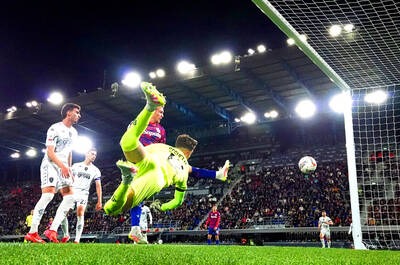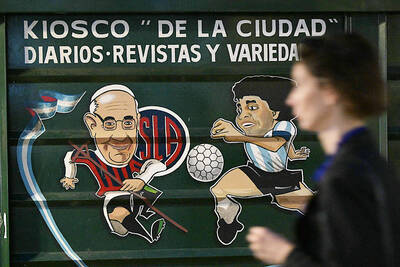Russell Coutts and Larry Ellison are certain they made the right decision to have the next America’s Cup sailed in fast 72 foot (21.9m) catamarans.
While traditionalists aren’t so sure about the move, Coutts and Ellison already envision the 72 foot cats sprinting across San Francisco Bay in 2013 and pumping some adrenaline into the competition for the oldest trophy in international sports.
Coutts, who sailed undefeated through three straight America’s Cup matches for two different countries, raves about the 45 foot prototype catamaran being tested in his home country, New Zealand.
Oracle Corp CEO Ellison, the Silicon Valley maverick who helped bankroll Oracle Racing’s victory in last year’s America’s Cup, can’t wait to get his hands on the wheel of one.
“Modern sports have got to attract television viewers, they’ve got to attract kids, they’ve got to be exciting,” Ellison said after sailing with Coutts in the Oracle RC44 San Diego regatta last weekend. “They’ve got to be, if not extreme, borderline extreme. The America’s Cup, I believe, should be the best sailors sailing the fastest boats. That’s not what it’s been. It’s been the best sailors, I think, but not anywhere near the fastest boats. I think now we will meet the goal of, ‘Boy, that’s an America’s Cup boat. That’s an America’s Cup yacht. That’s the fastest boat on the planet.’”
An America’s Cup World Series will begin later this year at ports around the world in the 45 foot cats. The 72 footers will come online next year.
Oracle Racing used a massive, 90-by-90 foot trimaran with a radical 223 foot wing sail to sweep two races against Alinghi of Switzerland in February last year off Valencia, Spain, and bring the silver trophy to the Golden Gate Yacht Club.
That was a one-off showdown born out of a long, bitter court fight.
In a shake-up designed to make the America’s Cup more modern and fan-friendly, Oracle Racing and the Italian syndicate that represents challengers decided to switch from plodding sloops to 72 foot cats with wing sails for 2013.
Coutts recently sailed the prototype AC45 and said he was “more convinced than ever” that it’s the right direction for sailing’s marquee regatta.
Coutts said that once he sailed the AC45, he decided he would be helming one in the AC World Series. Jimmy Spithill, who steered the trimaran last year, will be at the wheel of another AC45 for Oracle.
“I can understand the people on the outside, sometimes they don’t understand what’s happening. It’s normal. But I think if you jumped on an AC45 and sailed it for a day, pretty much everyone that’s done that has come off it and said, ‘This is a no-brainer,’” said Coutts, the CEO of Oracle Racing. “The boats will be great boats.”
Coutts guesses that once Ellison gets the chance to sail one, “He’ll just say, ‘Get me one of these boats.’ He’ll want to drive one.”
The AC45 capsized last month after getting hit by a freak breeze.
“It probably won’t be the last to capsize,” Coutts said. “In some ways, it’ll add to the spectacle.”
Once the 72 footers come online, “It’ll be another level again,” Coutts said. “Obviously in terms of scale, they’ll be fantastic. Very fast, very powerful.”
The wing sail will be bigger than the wing of a Boeing 747.
While the heavy sloops used from 1992 to 2007 would bury their bows in waves and strain to accelerate, the AC72s will speed across the water as fast as 30 knots, their windward hulls flying out of the water. The AC45 can reach 25 knots. By comparison, the high-performance RC44 sloops — co-designed by Coutts — were going about 12 to 13 knots in brisk conditions last week on San Diego Bay.
“Russell tells me after I drive an AC45, the RC44 is going to seem boring, which is hard to believe,” Ellison said. “That’s the most fun monohull I’ve ever driven.”
Although spectators got a close-up view of the RC44 regatta on San Diego Bay, it paled compared to what Coutts and Ellison expect from the America’s Cup in San Francisco.
“I think it’ll be so much better,” Coutts said. “Honestly, I really don’t think most people can imagine what it’ll be like yet. A fleet race in 72 foot cats, all doing 30 knots-plus, really close to the shore at times, sometimes the odd incident, maybe a capsize, you know what I mean? I think it’s just going to be a new dimension for the sport.”

Bologna on Thursday advanced past Empoli to reach their first Coppa Italia final in more than half a century. Thijs Dallinga’s 87th-minute header earned Bologna a 2-1 win and his side advanced 5-1 on aggregate. Giovanni Fabbian opened the scoring for Bologna with a header seven minutes in. Then Viktor Kovalenko equalized for Empoli in the 30th minute by turning in a rebound to finish off a counterattack. Bologna won the first leg 3-0. In the May 14 final in Rome, Bologna are to face AC Milan, who eliminated city rivals Inter 4-1 on aggregate following a 3-0 win on Wednesday. Bologna last reached the

If the Wild finally break through and win their first playoff series in a decade, Minnesota’s top line likely will be the reason. They were all over the Golden Knights through the first two games of their NHL Western Conference quarter-finals series, which was 1-1 going back to Minnesota for Game 3 today. The Wild tied the series with a 5-2 win on Tuesday. Matt Boldy had three goals and an assist in the first two games, while Kirill Kaprizov produced two goals and three assists. Joel Eriksson Ek, who centers the line, has yet to get on the scoresheet. “I think the biggest

From a commemorative jersey to a stadium in his name, Argentine soccer organizers are planning a slew of tributes to their late “Captain” Pope Francis, eulogized as the ultimate team player. Tributes to the Argentine pontiff, a lifelong lover of the game, who died on Monday at the age of 88, have been peppered with soccer metaphors in his homeland. “Francisco. What a player,” the Argentine Football Federation (AFA) said, describing the first pope from Latin America and the southern hemisphere as a generational talent who “never hogged the ball” and who showed the world “the importance of having an Argentine captain,

Noelvi Marte on Sunday had seven RBIs and hit his first career grand slam with a drive off infielder Jorge Mateo, while Austin Wynn had a career-high six RBIs as the Cincinnati Reds scored their most runs in 26 years in a 24-2 rout of the Baltimore Orioles. Marte finished with five hits, including his eighth-inning homer off Mateo. Wynn hit a three-run homer in the ninth off catcher Gary Sanchez. Cincinnati scored its most runs since a 24-12 win against the Colorado Rockies on May 19, 1999, and finished with 25 hits. Baltimore allowed its most runs since a 30-3 loss to